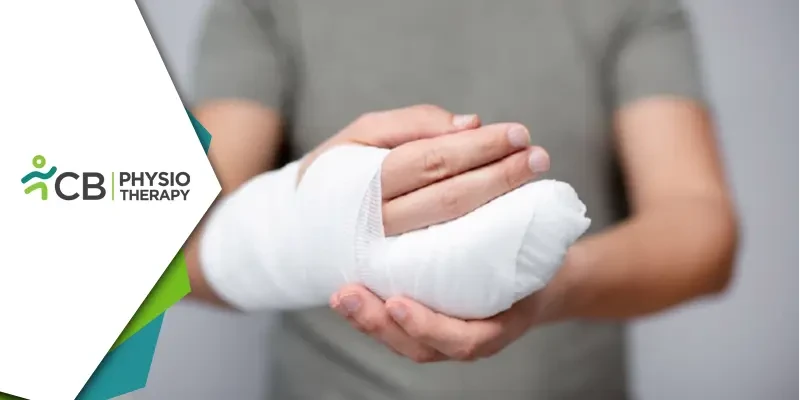Hand injuries can be debilitating, especially when they involve crushing forces. Crush injuries are common in industrial, agricultural, and household accidents, and they can lead to severe complications if not treated promptly and effectively. This blog delves into the nature of crush injuries to the hand and highlights physiotherapy's essential role in recovery and rehabilitation.
What is a Crush Injury?
A crush injury occurs when the hand, is subjected to high compressive forces. This type of injury can involve multiple structures including bones, muscles, tendons, ligaments, nerves, and blood vessels. The severity of a crush injury can vary from mild bruising to complex fractures, nerve damage, and even tissue necrosis. In the worst cases, crush injuries can lead to amputation. Common scenarios leading to crush injuries include industrial accidents like heavy machinery, such as presses or rollers, which can cause severe damage to hands, agricultural work like farmers often use powerful equipment that can lead to hand crush injuries, even domestic incidents like doors, heavy furniture, or even accidents can lead to crushed fingers or hands.When a hand is crushed, multiple layers of tissue are damaged. Key factors that influence the extent of injury include the duration of compression, the force applied, and the immediate management. Common damage observed includes torn muscles, tendons, and ligaments, leading to loss of function, swelling, bruising, and bleeding, high force impacts can break bones, leading to unstable fractures or comminuted fractures (bone shattered into multiple pieces), nerves running through the hand can be damaged, leading to sensory loss, weakness, or even paralysis of affected areas, blood vessels may be ruptured, leading to compromised blood flow, increasing the risk of ischemia and tissue necrosis, a serious complication where swelling within a muscle compartment increases pressure, leading to decreased blood flow, which can cause permanent tissue damage.
Immediate Management of Crush Injuries
The immediate goal is to prevent further damage and preserve life and function. This often includes:1: First Aid: Controlling bleeding, stabilizing fractures, and ensuring that the patient is stabilized.
2: Emergency Medical Care: This may involve surgery to debride damaged tissue, repair fractures, and restore blood flow.
3: Amputation: In severe cases, where tissue viability is compromised, amputation may be necessary.
Once the acute phase is managed, the focus shifts to rehabilitation, where physiotherapy plays a vital role.
Role of Physiotherapy in Rehabilitation
Physiotherapy is integral to the rehabilitation of crush injuries, facilitating recovery, restoring function, and improving quality of life. The physiotherapist’s role involves assessment, treatment planning, and the implementation of specialized techniques tailored to each patient’s needs.1. Pain Management
Post-injury pain can be significant and hinder progress in rehabilitation. Physiotherapists use a combination of modalities to manage pain, including:
Electrotherapy: Techniques such as transcutaneous electrical nerve stimulation (TENS) can help reduce pain.
Heat and Cold Therapy: Ice can reduce acute inflammation, while heat may be useful later in easing stiffness.
Manual Therapy: Gentle mobilizations and massage can reduce discomfort and improve circulation.
2. Edema Control
Swelling is a common issue following crush injuries. Physiotherapists employ various techniques to manage edema:
Elevation and Compression: Elevating the hand and using compression garments can reduce fluid accumulation.
Lymphatic Drainage: Manual lymphatic drainage helps move excess fluid out of the affected area.
Active Movement: Gentle movements can stimulate circulation and reduce swelling.
3. Restoration of Mobility and Joint Function
Stiffness and contractures are common after crush injuries, especially if immobilization was required. Physiotherapy focuses on regaining joint range of motion (ROM) and flexibility:
Joint Mobilizations: Techniques aimed at improving joint capsule mobility.
Stretching Exercises: Gentle stretches help maintain or improve muscle and tendon flexibility.
Splinting: Custom splints may be used to position the hand correctly and prevent deformities.
4. Strengthening and Muscle Re-Education
Once healing allows, strengthening exercises are introduced to rebuild muscle power and endurance:
Isometric Exercises: These exercises are started early when movement is limited.
Progressive Resistance Training: Gradual resistance exercises help rebuild hand strength.
Functional Strengthening: Activities mimicking daily tasks are used to ensure functional recovery.
5. Sensory Retraining
Nerve injuries can lead to altered or lost sensation, requiring specialized interventions:
Desensitization Techniques: Gradual exposure to various textures and temperatures helps normalize sensation.
Sensory Re-Education: Exercises that involve recognizing shapes, textures, or temperatures are employed to retrain the nervous system.
Mirror Therapy: For cases with sensory loss or phantom limb sensations post-amputation, mirror therapy can assist in recovery.
6. Functional Training and Occupational Therapy
Ultimately, the goal is to return the patient to daily activities and work. Functional training addresses:
Fine Motor Skills: Exercises to improve dexterity, precision, and hand-eye coordination.
Grip Strength: Training that targets various grips (e.g., power grip, pinch grip) for daily tasks.
Work-Specific Training: Exercises that simulate workplace tasks to ensure a smooth transition back to employment.
Crush injuries to the hand can have devastating consequences if not properly managed. However, with timely medical intervention and a structured physiotherapy program, significant recovery is achievable. Physiotherapy not only addresses the physical aspects of recovery but also plays a role in the psychological and functional reintegration of the patient, ensuring the best possible quality of life post-injury.

